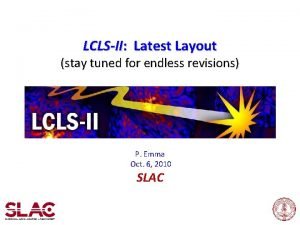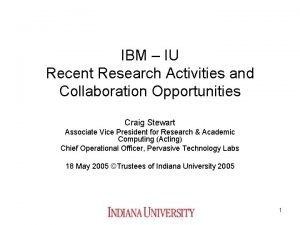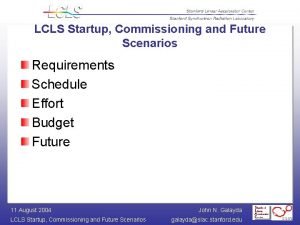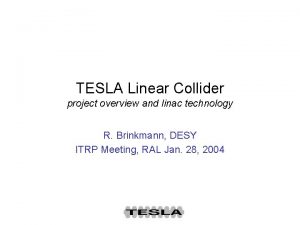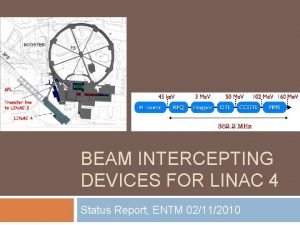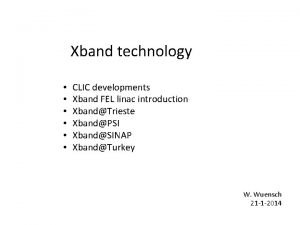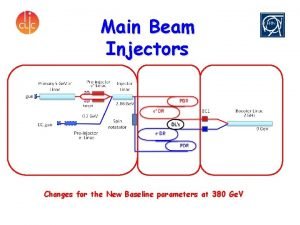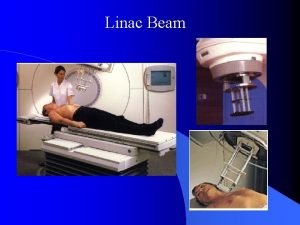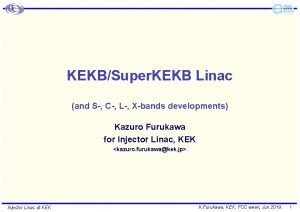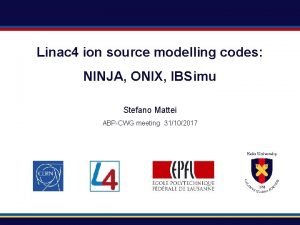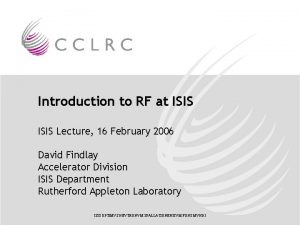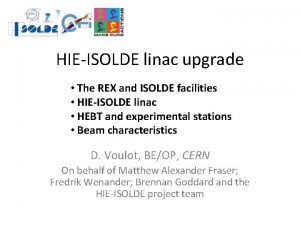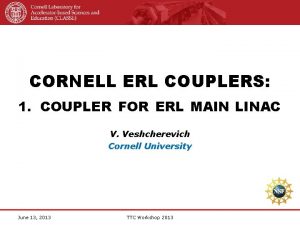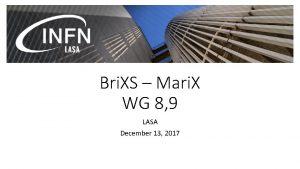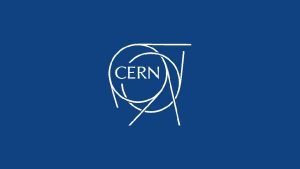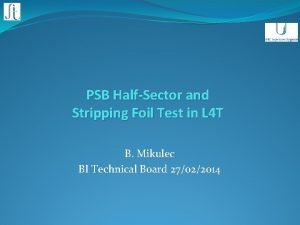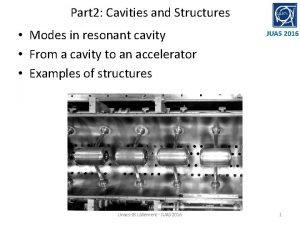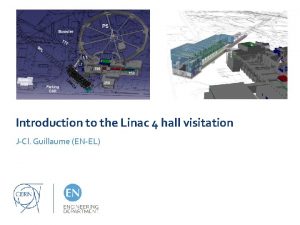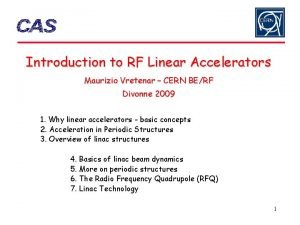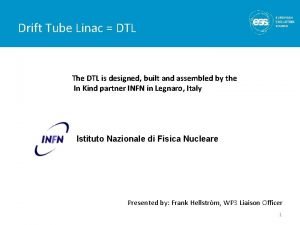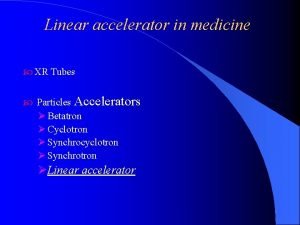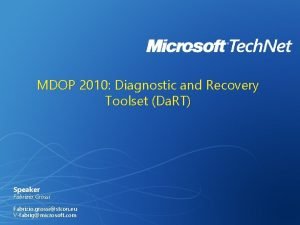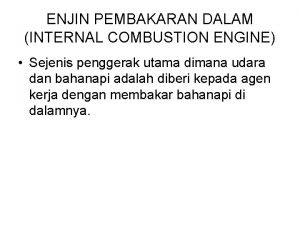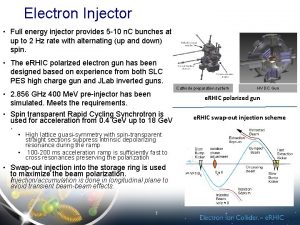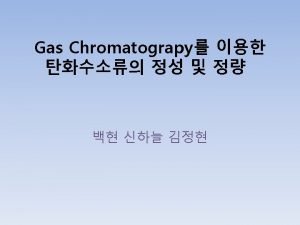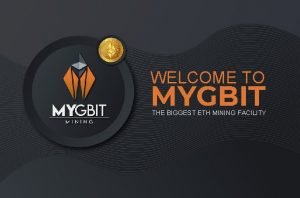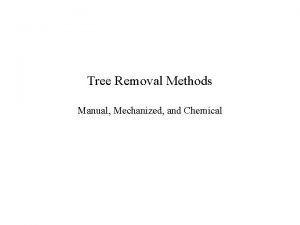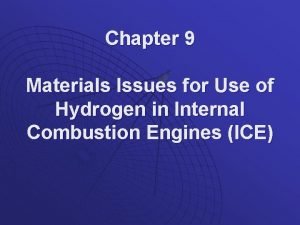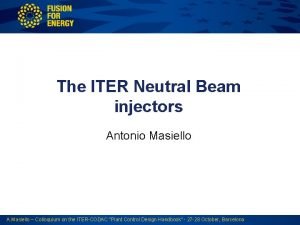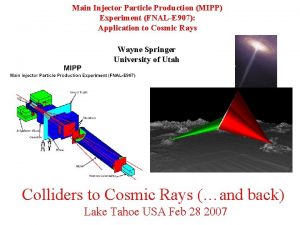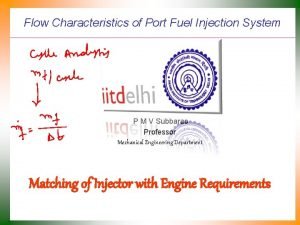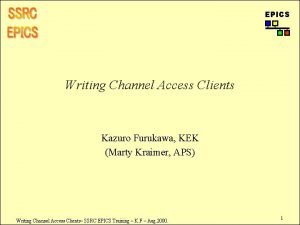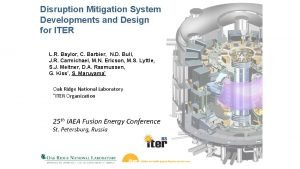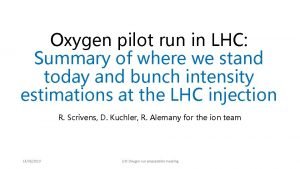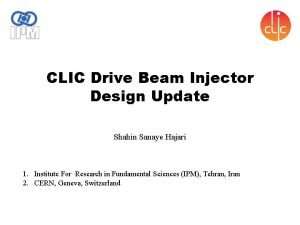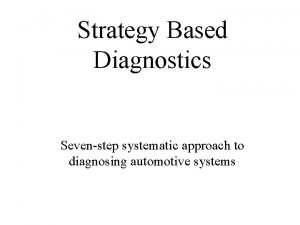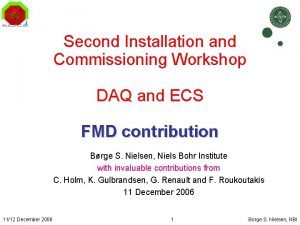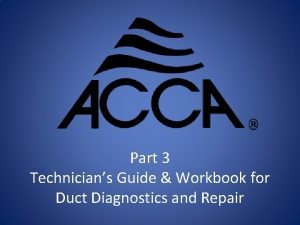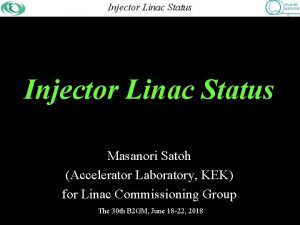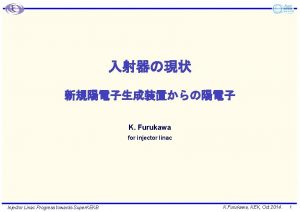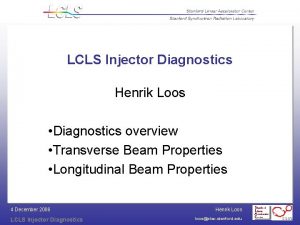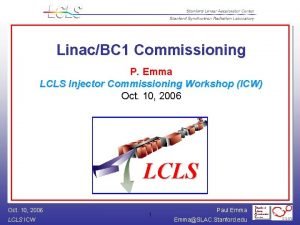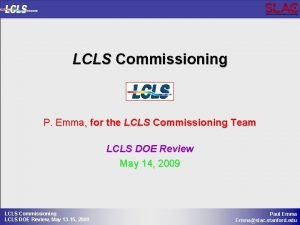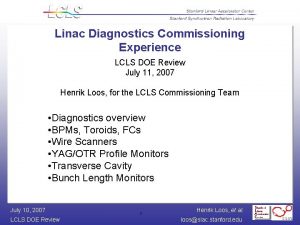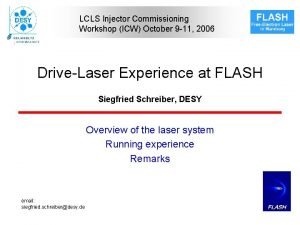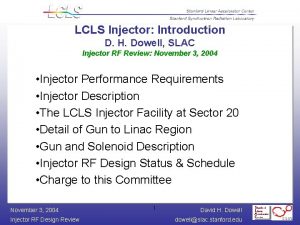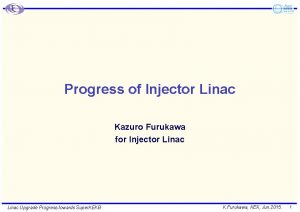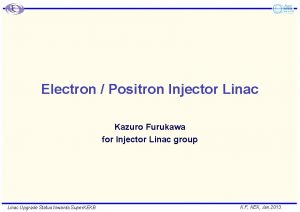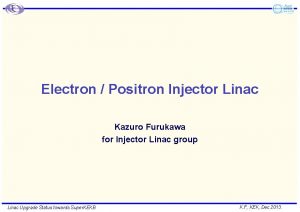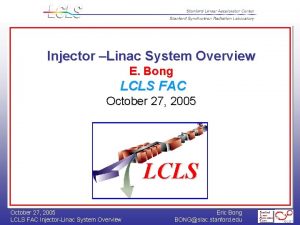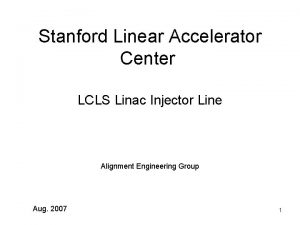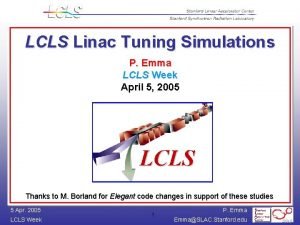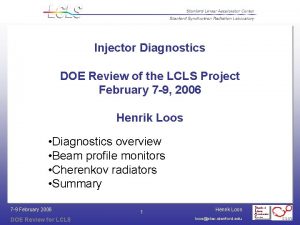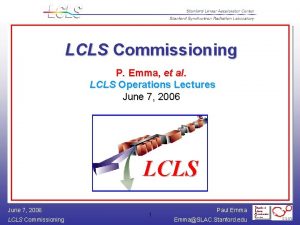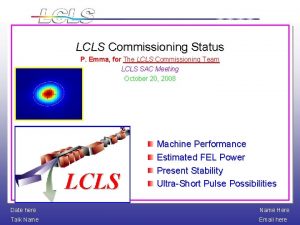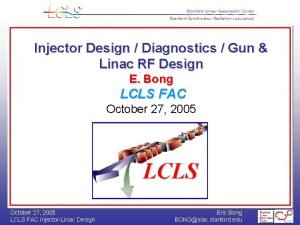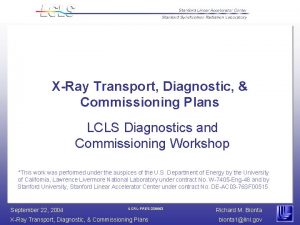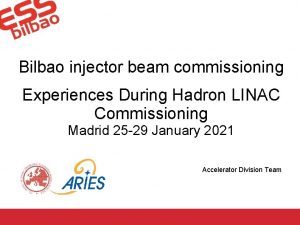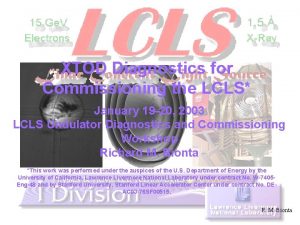LCLS Diagnostics and Commissioning Workshop Injector Linac and






















![Calibration scan for RF transverse deflecting cavity • Beam centroid [pixels] Bunch length calibrated Calibration scan for RF transverse deflecting cavity • Beam centroid [pixels] Bunch length calibrated](https://slidetodoc.com/presentation_image_h2/08012a416c080f17cb4d99d3d5958e8b/image-23.jpg)

































- Slides: 56

LCLS Diagnostics and Commissioning Workshop Injector, Linac and Undulator Diagnostics and Beam Position Monitors P. Krejcik September 22 -23, 2004 LCLS Diagnostics and Commissioning Workshop P. Krejcik pkr@slac. stanford. edu

Context of Diagnostics in Commissioning Review scope of proposed diagnostics Emphasize that diagnostics themselves need commissioning Consider if full features (resolution, automation) are needed at beginning of commissioning Implicit sequence of commissioning: e. g. feedbacks after BPMs commissioned; slice parameters need prof. monitors and TCAVs September 22 -23, 2004 LCLS Diagnostics and Commissioning Workshop P. Krejcik pkr@slac. stanford. edu

Readiness of diagnostic systems Which SLC diagnostics should be preserved? Technology choices still being made on some new systems BPM modules – trying to attain desired resolution Prof monitor cameras – resolution, controls integration, data rate Some diagnostics are turnkey systems, others are R&D projects R&D still required for ultrafast diagnostics CSR THz power bunch length monitors EO bunch profiling September 22 -23, 2004 LCLS Diagnostics and Commissioning Workshop P. Krejcik pkr@slac. stanford. edu

Dynamic Aspects of Commissioning Initially diagnose a wildly mis-tuned and unstable machine Yet the same diagnostics should ultimately have finesse to optimize SASE operation Deal with imperfect and uncalibrated settings Detective work for finding hardware faults Quantify magnitude and sources of jitter September 22 -23, 2004 LCLS Diagnostics and Commissioning Workshop P. Krejcik pkr@slac. stanford. edu

Diagnostics Roadmap for electrons Bunch charge Trajectory resolution • Position • Angle • Energy • Setup • Tuning Beam size resolution F E E D B A C K • Emittance • Energy spread Slice parameters resolution Bunch length & DT development • Longit. profile • Single shot rms Noninvasive 120 Hz • Emittance • Energy spread Invasive Stabilization response • Jitter characterization September 22 -23, 2004 LCLS Diagnostics and Commissioning Workshop P. Krejcik pkr@slac. stanford. edu

Accelerator System Diagnostics* • • • 180 BPMs at quadrupoles and in each bend system 8 Energy (BPM) E , energy spread (Prof) E measurements : 5 Emittance gex, y measurements (Profs, Wire Scanners) : 2 Transverse RF deflecting Cavities for slice measurements 5 Bunch length monitors RF gun * See also P. Emma talk how optics is optimized for diagnostics L 0 3 prof. mon. ’s (Dyx, y = 60°) L 1 upstream linac DL 1 L 2 X BC 1 L 3 BC 2 DL 2 undulator LTU September 22 -23, 2004 LCLS Diagnostics and Commissioning Workshop P. Krejcik pkr@slac. stanford. edu Dump E, DE

Beam Position Monitoring requirements September 22 -23, 2004 LCLS Diagnostics and Commissioning Workshop P. Krejcik pkr@slac. stanford. edu

Beam Position Monitors Stripline BPMs in the injector and linac (existing) and in the LTU Differencing large numbers Mechanical precision Fabrication by printing electrodes on ceramic tubes Drift in electronics Digital signal processing Cavity BPMs in the undulator, LTU launch Signal inherently zero at geometric center C-band (inexpensive) signal needs to be mixed down in the tunnel September 22 -23, 2004 LCLS Diagnostics and Commissioning Workshop P. Krejcik pkr@slac. stanford. edu

Stripline versus Cavity BPM Signals P l/4 Stripline f 700 MHz ADC x 4 RF in l 500 MHz BP filter C-band cavity ~5 GHz Dipole mode coupler Mixer LO sync’ed to RF September 22 -23, 2004 LCLS Diagnostics and Commissioning Workshop IF Digital processing Control system 119 MHz Clock 24 th harmonic • noise (resolution) minimized by removing analog devices in front of ADC that cause attenuation • drift minimized by removing active devices in front of ADC P. Krejcik pkr@slac. stanford. edu

Simplistic View of Digital BPMs Is the purely digital approach the best way to go? Must always maximize signal to noise for best resolution So eliminate any cause of attenuation: couplers, hybrids, active devices etc. This also eliminates drift which causes offsets Other approaches also try to do this: e. g. AM to PM conversion with a hybrid and then digitize Might as well digitize first, eliminate the middle men, and do the conversions digitally Ultimately left with calibrating the drift in the BPM cables, because ADCs are now very stable. September 22 -23, 2004 LCLS Diagnostics and Commissioning Workshop P. Krejcik pkr@slac. stanford. edu

Linac stripline BPMs • • Need to replace old BPM electronics Commercially available processing units look promising Beam testing of module as soon as funding available Test new BPM fabrication techniques http: //www. i-tech. si September 22 -23, 2004 LCLS Diagnostics and Commissioning Workshop P. Krejcik pkr@slac. stanford. edu

Analysis of Test Signals in the “Libera” module – S. Smith Measured signal to noise ratio implies resolution of 7 mm in a 10 mm radius BPM Identified fixable artifacts in data processing September 22 -23, 2004 LCLS Diagnostics and Commissioning Workshop P. Krejcik pkr@slac. stanford. edu

Cavity beam position monitors for the undulator and LTU R&D at SLAC – S. Smith NLC studies of cavity BPMs, S. Smith et al September 22 -23, 2004 LCLS Diagnostics and Commissioning Workshop Coordinate measuring machine verification of cavity interior • X-band cavity shown • Dipole-mode couplers P. Krejcik pkr@slac. stanford. edu

C-band beam tests of the cavity BPM – S. Smith cavity BPM signal versus predicted position at bunch charge 1. 6 n. C 25 mm • Raw digitizer records from beam measurements at ATF • C-band chosen for compatibility with wireless communications technology 200 nm • plot of residual deviation from linear response • << 1 mm LCLS resolution requirement September 22 -23, 2004 LCLS Diagnostics and Commissioning Workshop P. Krejcik pkr@slac. stanford. edu

LCLS BPM Testing is planned at the “Controls Test Stand” to be located at the FFTB, 2005. Evaluation of processor electronics Resolution determined by comparing several adjacet BPMs Possibility to test new striplines Copy the design of NLC C-band cavity BPMS September 22 -23, 2004 LCLS Diagnostics and Commissioning Workshop P. Krejcik pkr@slac. stanford. edu

Beam Size Measurement • Wire scanners, based on existing SLAC systems • Measures average projected emittance • But is minimally invasive and can be automated for regular monitoring • Profile monitors Single shot, full transverse profile YAG screen in the injector for greater intensity OTR screens in the linac and LTU for high resolution 1 mm foils successfully tested in the SPPS: Small emittance increase disrupts FEL, but no beam loss -1: 1 imaging optics => ~ 9 mm resolution Used in combination with TCAV for slice energy spread and emittance CTR for bunch length measurement OTR image taken in the SPPS Courtesy M. Hogan, P. Muggli et al September 22 -23, 2004 LCLS Diagnostics and Commissioning Workshop P. Krejcik pkr@slac. stanford. edu

Profile Monitor Camera Specification • Digital camera technology • Not TV camera that subsequently needs a frame grabber • External trigger supplied to the camera by control system • 30 fps at 1280 x 960 pixels, 10 bit resolution • Digital image read out over ethernet or firewire • Inexpensive, commercially available ~$1 k – Z. Salata. September 22 -23, 2004 LCLS Diagnostics and Commissioning Workshop P. Krejcik pkr@slac. stanford. edu

Profile Monitor Camera Dynamic Range • How many bits are necessary to see the tails? saturation 3 s needs 10 bits 4 s needs 12 bits September 22 -23, 2004 LCLS Diagnostics and Commissioning Workshop P. Krejcik pkr@slac. stanford. edu

Profile monitor commissioning Can be tested off the beamline at the Controls Test Stand Evaluate data acquisition and integration into the control system test a complete optical setup and measure optical resolution and wavelength response September 22 -23, 2004 LCLS Diagnostics and Commissioning Workshop P. Krejcik pkr@slac. stanford. edu

Bunch length diagnostic comparison Device Type Invasive Single shot measurement Abs. or rel. Timing Detect measurement m bunching Yes: Steal 3 pulses No: 3 pulses Absolute No No Coherent Radiation Spectral power No for CSR Yes for CTR Yes Relative No Yes Coherent Radiation Autocorrelation No for CSR Yes for CTR No Absolute No No Electro Optic Sampling No Yes Absolute Yes No Energy Wake-loss Yes No Relative No No RF Transverse Deflecting Cavity (2 nd moment only) September 22 -23, 2004 LCLS Diagnostics and Commissioning Workshop P. Krejcik pkr@slac. stanford. edu

Bunch Length Measurements with the RF Transverse Deflecting Cavity 30 MW Bunch length reconstruction s y Measure streak at 3 different phases (Streak size)2 2. 4 m Cavity on sz = 90 mm Cavity on - 180° Cavity off Asymmetric parabola indicates incoming tilt to beam September 22 -23, 2004 LCLS Diagnostics and Commissioning Workshop P. Krejcik pkr@slac. stanford. edu

Commissioning of the Transverse Cavities Calibration of the deflection strength in units of pixels on the profile monitor Also requires beam trajectory feedback to stabilize the RF phase of the deflecting cavity Prof monitor image acquisition fully integrated into the control system September 22 -23, 2004 LCLS Diagnostics and Commissioning Workshop P. Krejcik pkr@slac. stanford. edu
![Calibration scan for RF transverse deflecting cavity Beam centroid pixels Bunch length calibrated Calibration scan for RF transverse deflecting cavity • Beam centroid [pixels] Bunch length calibrated](https://slidetodoc.com/presentation_image_h2/08012a416c080f17cb4d99d3d5958e8b/image-23.jpg)
Calibration scan for RF transverse deflecting cavity • Beam centroid [pixels] Bunch length calibrated in units of the wavelength of the S-band RF Further requirements for LCLS: • High resolution OTR screen • Wide angle, linear view optics Cavity phase [deg. S-Band] September 22 -23, 2004 LCLS Diagnostics and Commissioning Workshop P. Krejcik pkr@slac. stanford. edu

OTR Profile Monitor in combination with RF Transverse Deflecting Cavity - detailed applications in P. Emma talk Simulated digitized video image Injector DL 1 beam line is shown Best resolution for slice energy spread measurement would be in adjacent spectrometer beam line. September 22 -23, 2004 LCLS Diagnostics and Commissioning Workshop P. Krejcik pkr@slac. stanford. edu

Coherent radiation from the electron bunch Frequency domain Spectral power in a fixed bandwidth Spectrometry Autocorrelation Time domain Electro optic sampling Measured directly near the bunch Or transported out of the beam line September 22 -23, 2004 LCLS Diagnostics and Commissioning Workshop P. Krejcik pkr@slac. stanford. edu

Diagnosing Coherent Radiation 1. spectral power Smooth Gaussian bunch spectrum from BC 1 Dl Fixed BW detector Signal prop. 1/sz - J. Wu Bunch length signal for RF feedback • Measure bunch length With 5% microbunching September 22 -23, 2004 LCLS Diagnostics and Commissioning Workshop • Detect microbunching P. Krejcik pkr@slac. stanford. edu

BC 2 Bunch length monitor spectrum - based on coherent spectral power detection BC 2 bunch length feedback requires THz CSR detector Demonstrated with CTR at SPPS 4 THz main peak Spikes in the distribution now have same spectral signature as microbunching September 22 -23, 2004 LCLS Diagnostics and Commissioning Workshop P. Krejcik pkr@slac. stanford. edu

Diagnosing Coherent Radiation 2. autocorrelation z 9 m m Transition radiation is coherent at wavelengths longer than the bunch length, l>(2 p)1/2 sz September 22 -23, 2004 LCLS Diagnostics and Commissioning Workshop Limited by long wavelength cutoff and absorption resonances SLAC SPPS measurement: P. Muggli, M. Hogan P. Krejcik pkr@slac. stanford. edu

Transport issues for THz radiation Simple model: Gaussian, sz=20 µm, d=12. 7 µm, n=3 Mylar window+splitter Mylar resonances • Fabry-Perot resonance: l=2 d/m, m=1, 2, … • Modulation/dips in the interferogram • Signal attenuated by Mylar: (RT)2 per sheet • Smaller measured width: P. Muggli, M. Hogan September 22 -23, 2004 LCLS Diagnostics and Commissioning Workshop s. Autocorrelation < sbunch ! P. Krejcik pkr@slac. stanford. edu

Developments in autocorrelation techniques Investigate other detector types for wavelength dependance Golay cell Beam splitters without wavelength dependance Single shot autocorrelator Camera records fringes on single shot Use CSR from chicane bed September 22 -23, 2004 LCLS Diagnostics and Commissioning Workshop P. Krejcik pkr@slac. stanford. edu

Bunch length scan performed while observing spectral power with THz detector Comparison of bunch length minimized according to wakefield loss and THz power foil Wake energy loss LINAC Linac phase THz power Coherent transition radiation wavelength comparable to bunch length FFTB Pyroelectric detector GADC September 22 -23, 2004 LCLS Diagnostics and Commissioning Workshop P. Krejcik pkr@slac. stanford. edu

Dither feedback control of bunch length minimization at SPPS - L. Hendrickson Bunch length monitor response Feedback correction signal “ping” optimum Dither time steps of 10 seconds Linac phase September 22 -23, 2004 LCLS Diagnostics and Commissioning Workshop Jitter in bunch length signal over 10 seconds ~10% rms P. Krejcik pkr@slac. stanford. edu

Diagnosing Longitudinal phase space: Energy spectrum versus Bunch length signal - Muggli, Hogan et al Jitter in the compressor phase: Resuting energy profile Corresponding bunch length signal jitter Single shot measurements September 22 -23, 2004 LCLS Diagnostics and Commissioning Workshop signal P. Krejcik pkr@slac. stanford. edu

9 Ge. V SPPS Four Dipole Chicane LB=1. 80 m B=1. 60 T Momentum compaction R 56= – 75 mm BPM - energy Prof. Monitor - DE s Linac chirp Measured energy spread LT=14. 3 m 1. 6% Correlated z 0 September 22 -23, 2004 energy 1. 2 mm LCLS Diagnostics and Commissioning Workshop spread z SR background 50 mm P. Krejcik pkr@slac. stanford. edu

Measured and predicted energy spread from wakefield chirp in SPPS Special setup to give 100 mm bunch length with more charge at the head of the bunch September 22 -23, 2004 LCLS Diagnostics and Commissioning Workshop Measured. P. at end of linac Krejcik pkr@slac. stanford. edu

Wakefields change not only the energy spread in the bunch But also the centroid energy of the bunch Fast means of determining relative bunch length September 22 -23, 2004 LCLS Diagnostics and Commissioning Workshop P. Krejcik pkr@slac. stanford. edu

Relative bunch length measurement based on wakefield energy loss scan Energy change measured at the end of the linac as a function of the linac phase (chirp) upstream of the compressor chicane Predicted shape due to wakeloss plus RF curvature P. Emma, K. Bane Shortest bunch has greatest energy loss Predicted wakeloss___ For bunch length s z __ September 22 -23, 2004 LCLS Diagnostics and Commissioning Workshop P. Krejcik pkr@slac. stanford. edu

Coherent radiation from the electron bunch Frequency domain Spectral power Spectrometry Autocorrelation Time domain Electro optic sampling Measured directly near the bunch Or transported out of the beam line September 22 -23, 2004 LCLS Diagnostics and Commissioning Workshop P. Krejcik pkr@slac. stanford. edu

SPPS Electro Optic Bunch Length Measurement with in-vacuum crystal Defining aperture M 1 EO xtal M 2 Beam axis Geometry chosen to measure direct electric field from bunch, not wakefield Modelled by H. Schlarb Probe laser September 22 -23, 2004 LCLS Diagnostics and Commissioning Workshop s on r t c ele P. Krejcik pkr@slac. stanford. edu

Features of the SPPS Electro Optic Setup Compressed pulse from the users pump-probe Ti: Sa laser oscillator Transported low power pulse over ~150 m fiber to the electron beam line OTR provides coarse timing Ti: Sa oscillator Stretcher Shaper Fiber launch ~150 m fiber EO xtl e- p polarizing s beamsplitter September 22 -23, 2004 LCLS Diagnostics and Commissioning Workshop imaging optics OTR P. Krejcik pkr@slac. stanford. edu

Features of the SPPS Electro Optic Setup Fiber incorporated in pulse compression setup including compensating fiber dispersion with a spatial light modulator Cavalieri et al, FOCUS Group U. Michigan Grating pair SLM 640 -pixel From stretcher September 22 -23, 2004 LCLS Diagnostics and Commissioning Workshop To fiber P. Krejcik pkr@slac. stanford. edu

Features of the SPPS Electro Optic Setup Crystal mounted close to electron beam Avoid wakefields from smaller apertures Zn. Te crystal: 200 um thick EO coefficient, phase match, phonon resonances September 22 -23, 2004 LCLS Diagnostics and Commissioning Workshop P. Krejcik pkr@slac. stanford. edu

Electro-Optical Sampling at SPPS – A. Cavalieri et al. Single-Shot Bunch length scan <300 fs EO crystal Line image camera analyzer Pol. Laser pulse Timing Jitter 170 fs rms polarizer Er Electron bunch September 22 -23, 2004 LCLS Diagnostics and Commissioning Workshop P. Krejcik pkr@slac. stanford. edu

Electro optic resolution limits Spatial imaging resolution limits time resolution Crossing angle determines width of time window and temporal resolution Resolution limit then set by crystal thickness and the phase velocity mismatch Crystal material chosen to minimize phase mismatch September 22 -23, 2004 LCLS Diagnostics and Commissioning Workshop P. Krejcik pkr@slac. stanford. edu

Electro optic resolution limits Future experiments Smaller crossing angle Smaller angle magnifies time coordinate on spatial axis But reduces the time window to accommodate beam jitter New chamber T. Montagne Ti: Sapphire laser e- EO polymer films Strong EO coefficient May not last long Higher laser power cross correlation techniques (Jamison et al) 200 mm thick Zn. Te crystal Laser amplifier located near beamline September 22 -23, 2004 LCLS Diagnostics and Commissioning Workshop P. Krejcik pkr@slac. stanford. edu

Synchronization of the Laser timing Jitter in the laser timing effects Electro optic bunch timing measurement Pump-probe timing for the users Enhancement schemes using short pulse lasers September 22 -23, 2004 LCLS Diagnostics and Commissioning Workshop P. Krejcik pkr@slac. stanford. edu

SPPS Laser Phase Noise Measurements – R. Akre 476 MHz M. O. MDL 3 km fiber ~1 km Ti: Sa laser osc VCO x 6 2856 MHz to linac EO diode Phase detector scope September 22 -23, 2004 LCLS Diagnostics and Commissioning Workshop P. Krejcik pkr@slac. stanford. edu

Energy and Bunch Length Feedback Loops E Vrf(L 1) Φrf(L 2) E Φrf(L 3) E DL 1 Vrf(L 0) L 0 E Φrf(L 1) sz DL 1 Spectr. L 1 sz Φrf(L 2) BC 2 BC 1 L 2 L 3 BSY 50 B 1 DL 2 4 energy feedback loops 2 bunch length feedback loops 120 Hz nominal operation, <1 pulse delay Progressive commissioning schedule September 22 -23, 2004 LCLS Diagnostics and Commissioning Workshop P. Krejcik pkr@slac. stanford. edu

Closed Loop Response of Orbit Feedback Undulator trajectory launch loop to operate at 120 Hz, <1 pulse delay Damps jitter below 10 Hz i. e. need stability above 10 Hz! At lower rep. rates, less damping Linac orbit loops to operate at 10 Hz because of corrector response time Gain bandwidth shown for different loop delays Antidamp Damp - L. Hendrickson September 22 -23, 2004 LCLS Diagnostics and Commissioning Workshop P. Krejcik pkr@slac. stanford. edu

Remaining intra-undulator diagnostics – from Bingxin Yang, Lehman Review August ‘ 04 Location: every long break (905 mm) Diagnostics chamber length: 425 mm Functional components RF BPM, Cherenkov detector, OTR profiler, wire scanner, x-ray (intensity) diagnostics September 22 -23, 2004 LCLS Diagnostics and Commissioning Workshop P. Krejcik pkr@slac. stanford. edu

FY 04 accomplishments – from Bingxin Yang, Lehman Review August ‘ 04 Layout of diagnostics chamber OTR profiler Camera module designed Wire scanner Scanner design in progress Wire card adapt SLAC design X-ray diagnostics design Beam intensity: double crystal Beam profile: imaging detector September 22 -23, 2004 LCLS Diagnostics and Commissioning Workshop P. Krejcik pkr@slac. stanford. edu

Major issues at UCLA workshop – from Bingxin Yang, Lehman Review August ‘ 04 Beam damage of optical components Example from Marc Ross’ coupon test, LINAC 2000 Saturated FEL beam deposit higher energy density Desirable information Trajectory accuracy (Dx~1 mm) Effective K (DK/K ~ 1. 5× 10 -4) Relative phase (Df~10º) Intensity gain (DE/E~0. 1%, z-) Undulator field quality September 22 -23, 2004 LCLS Diagnostics and Commissioning Workshop P. Krejcik pkr@slac. stanford. edu

Rethink x-ray diagnostics (Galayda) – from Bingxin Yang, Lehman Review August ‘ 04 Intra-undulator diagnostics Electron beam position monitor (BPM) Electron beam profiler (OTR & wire scanner) Low power x-ray Intensity measurements (R&D) Beam loss Monitor Far-field low-power x-ray diagnostics (R&D) Clean signature from spontaneous radiation Space for larger optics / detectors Single set advantage (consistency, lower cost) Goal = obtain “desirable information” September 22 -23, 2004 LCLS Diagnostics and Commissioning Workshop P. Krejcik pkr@slac. stanford. edu

Final Beam Dump Sensitive measurement of beam energy Optimized for energy spread resolution of 4*10 -5 (P. Emma) Bends smear out microbunching Dispersion hides emittance measurement Might be possible in the vertical plane September 22 -23, 2004 LCLS Diagnostics and Commissioning Workshop P. Krejcik pkr@slac. stanford. edu

Summary Diagnostics integrated into the LCLS design All systems require commissioning time to achieve LCLS resolution requirements New diagnostics still require R&D for bunch length and timing Developmental work at SPPS is critical Diagnostics being developed hand-in-hand with controls and feedbacks September 22 -23, 2004 LCLS Diagnostics and Commissioning Workshop P. Krejcik pkr@slac. stanford. edu

Appendix September 22 -23, 2004 LCLS Diagnostics and Commissioning Workshop P. Krejcik pkr@slac. stanford. edu
 Lcls
Lcls Lcls
Lcls Lcls schedule
Lcls schedule Linac
Linac Beam stopper linac
Beam stopper linac Linac
Linac Linac
Linac Linac treatment head
Linac treatment head Linac
Linac Linac
Linac Linac
Linac Linac
Linac Linac
Linac Linac
Linac Linac 4
Linac 4 Linac 4
Linac 4 Linac 4
Linac 4 Linac 4
Linac 4 Cern
Cern Linac 4
Linac 4 Flatining
Flatining Pressure regulator
Pressure regulator Diagnostics and recovery toolset
Diagnostics and recovery toolset Mitel 5000 hx
Mitel 5000 hx Integrated commissioning and progress system
Integrated commissioning and progress system Enjin pembakaran dalam
Enjin pembakaran dalam Electron injector
Electron injector Light vehicle diesel engines
Light vehicle diesel engines Splitless injector
Splitless injector Kioritz soil injector
Kioritz soil injector Mygbit cloud mining a.ş
Mygbit cloud mining a.ş Hypo hatchet tree injector
Hypo hatchet tree injector Mazzei injector selector
Mazzei injector selector Lbz injector balance rates
Lbz injector balance rates Uuu injector
Uuu injector Injector torch definition
Injector torch definition Atnaa cana
Atnaa cana Mix rite injectors
Mix rite injectors Michigan ffa skills contest
Michigan ffa skills contest Neutral beam injector
Neutral beam injector Cana injector
Cana injector Oxy blast
Oxy blast Experiment 907
Experiment 907 Mars injector
Mars injector Weber number
Weber number Acceleratorclientconnectioncallback
Acceleratorclientconnectioncallback Uuu injector
Uuu injector Iter coils
Iter coils Biolab oxygen injector
Biolab oxygen injector Injector update
Injector update Commissioning cycle
Commissioning cycle Amedd commissioning programs
Amedd commissioning programs Steps
Steps Gm strategy based diagnostics
Gm strategy based diagnostics Ecs commissioning
Ecs commissioning Heat pump balance point
Heat pump balance point Duct diagnostics
Duct diagnostics
